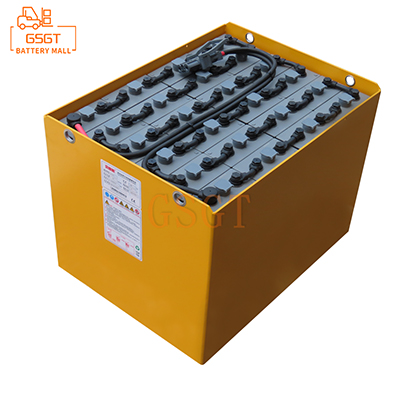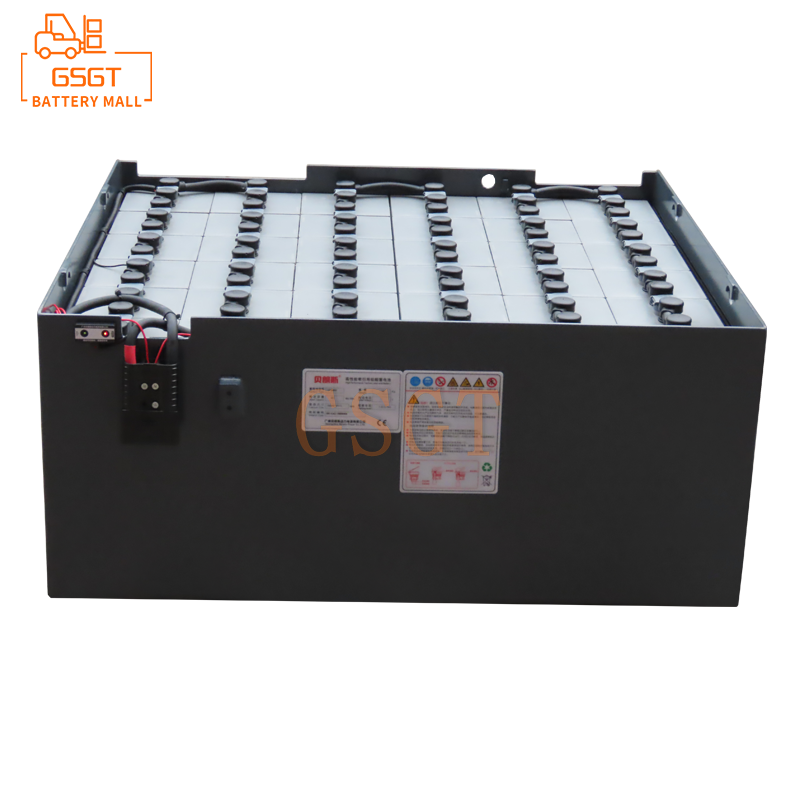Time:2025-04-22 12:12:48
Browse:596
1. Introduction
In the modern logistics and warehousing industry, forklifts, as important handling equipment, the performance and lifespan of their power source - lead-acid batteries - play a crucial role in the normal operation of forklifts. Good maintenance and upkeep not only ensure the efficient and stable operation of forklifts, but also reduce usage costs and decrease the frequency of malfunctions. This article will elaborate in detail on the entire process of maintaining and servicing lead-acid batteries in forklifts, providing comprehensive and practical guidance for forklift users.
2. Basic Principles and Characteristics of Lead-Acid Batteries
Lead-acid batteries are mainly composed of positive and negative plates, separators, electrolyte, casings and other parts. Its working principle is based on the electrochemical process. During charging, electrical energy is converted into chemical energy and stored in the battery. When discharging, chemical energy is converted back into electrical energy to provide power for the forklift. Lead-acid batteries have advantages such as low cost, mature technology and good high-current discharge performance, but they also have disadvantages such as heavy weight, the need for regular maintenance and relatively short service life. Understanding these characteristics is helpful for taking targeted measures during the maintenance process.
3. Inspection and Preparation Before Daily Use
(1) Visual inspection
Before each use of the forklift, a visual inspection of the lead-acid battery is required. Check if there are any damages or cracks in the battery casing. If there are any damages, it may cause the electrolyte to leak, which not only corrodes the forklift components but also affects the performance and service life of the battery. Check if the terminal posts are loose and if there is any oxidation. Loose terminal posts can cause poor contact and affect current transmission, while oxidation will increase resistance and reduce charging and discharging efficiency. If oxidation of the terminal post is found, it can be gently sanded with sandpaper and then coated with special protective grease.
(2) Check the electrolyte level
The electrolyte inside a lead-acid battery is one of the key factors to ensure its normal operation. Open the liquid injection hole cover on the battery and check whether the electrolyte level is within the specified scale range (generally 10-15 millimeters from the upper edge of the plates). If the liquid level is too low, the plates will be exposed to the air, causing sulfation of the plates and reducing the capacity of the battery. If the liquid level is too high, the electrolyte may overflow during charging or use. When the electrolyte level is too low, distilled water or special lead-acid battery replenishment liquid should be added. Do not add tap water, as the impurities in tap water will affect the performance of the battery.
(3) Inspection of connection lines
Check whether the connection lines between the battery and the forklift are firm and whether there is any damage or aging. Loose connection lines can cause an increase in contact resistance, leading to insufficient charging or unstable discharging, and may even cause safety accidents such as fires. Damaged and aged circuits are prone to short circuits or leakage and need to be replaced with new ones in a timely manner. Meanwhile, ensure that the joints of the connecting lines are clean and free of rust.
4. Precautions and Operating Procedures during the Charging Process
(1) Charging environment requirements
Choose a well-ventilated, dry and cool place for charging. During the charging process of lead-acid batteries, flammable gases such as hydrogen are produced. If they are charged in a confined space, the accumulation of hydrogen may cause an explosion. Meanwhile, the charging environment temperature should be controlled between 5℃ and 40℃. Both excessively high and low temperatures will affect the charging efficiency and the battery life. In addition, the charging area should be kept away from fire sources, heat sources and flammable and explosive items.
(2) Selection and Connection of Charging Equipment
Use a charger that matches the specifications of lead-acid batteries. Different models and capacities of batteries require different charging voltages and currents. If an incompatible charger is used, it may lead to insufficient charging or overcharging, which can damage the battery. When connecting the charger, first connect the negative terminal of the charger to the negative terminal of the battery, and then connect the positive terminal of the charger to the positive terminal of the battery. Make sure the connection is secure.
(3) Charging Operation Process
1. First charge: Newly purchased lead-acid batteries need to be charged for the first time. The first charge usually lasts for 18 to 24 hours to fully activate the active substances on the plates and increase the battery capacity.
2. Daily charging: When the battery's power remains at around 20% to 30%, it should be charged. During the charging process, closely observe the indicator lights and instrument displays of the charger. Under normal circumstances, the charging current is relatively large at the beginning of charging. As the charging proceeds, the current gradually decreases and the voltage gradually increases. When the charging current drops to a certain value and remains stable, and the voltage reaches the specified termination charging voltage (generally 2.5-2.7V per cell, 14.4-16.2V for 12V batteries) and remains unchanged for 2-3 hours, it indicates that the battery is basically fully charged.
3. Avoid overcharging and undercharging: Overcharging can cause the battery to heat up, accelerate the aging of the plates and the evaporation of the electrolyte. Undercharging will cause sulfation of the plates and reduce the capacity of the battery. Therefore, it is necessary to charge strictly in accordance with the charging time and parameters. Once the battery is fully charged, the charger should be turned off in a timely manner.
5. Key Points for Maintenance during Use
(1) Avoid high current discharge
When starting, accelerating and climbing a forklift, sudden large current discharge should be avoided. High current discharge can cause irreversible damage to the plates of lead-acid batteries and shorten their lifespan. When starting the forklift, the accelerator pedal should be pressed slowly to avoid sudden acceleration. When climbing a slope, adjust the vehicle speed and gear in advance to avoid suddenly increasing the accelerator halfway.
(2) Regular deep discharge
During the use of lead-acid batteries, deep discharge should be carried out regularly, usually once every 2 to 3 months. Deep discharge can activate the active substances on the plates and delay the sulfation of the plates. The method of deep discharge is to use the battery power to a relatively low level (but not completely drained), and then perform a full charge.
(3) Temperature Management
The performance of lead-acid batteries is greatly affected by temperature. When used in high-temperature environments, the working intensity of the forklift should be appropriately reduced to avoid prolonged continuous operation. At the same time, the frequency of checking the electrolyte level should be increased, and water should be replenished in a timely manner. In low-temperature environments, it is advisable to park the forklift in a warm indoor area as much as possible. If this is not feasible, insulation measures can be taken, such as installing insulation covers on the battery. When charging in a low-temperature environment, the battery temperature should be raised to above 5℃ first before charging; otherwise, it will affect the charging effect.
6. Regular deep maintenance and upkeep
(1) Electrolyte detection and adjustment
Every 1 to 2 months, use a hydrometer to test the specific gravity of the electrolyte. Under normal circumstances, the specific gravity of the electrolyte is between 1.28 and 1.30g/cm³ at 25℃. If the specific gravity is too low, it indicates that there is too much water in the electrolyte, which may be caused by overcharging or adding too much distilled water. The specific gravity can be increased by charging appropriately. If the specific gravity is too high, it indicates that the concentration of sulfuric acid in the electrolyte is too high, which may corrode the plates. Distilled water should be added for dilution. At the same time, test the pH of the electrolyte to ensure that its pH value is within an appropriate range. If the pH is abnormal, the electrolyte needs to be adjusted or replaced.
(2) Plate Inspection and Maintenance
Regularly open the battery casing and check the condition of the plates. Observe whether the plates have any bending, deformation, damage, vulcanization or other phenomena. Mild sulfation can be repaired by using the method of long-term charging with a small current. For severely vulcanized, bent deformed or damaged plates, they should be replaced in time. In addition, check whether the connection between the plates is firm and whether there is any loosening or breakage. If there are any problems, deal with them in time.
(3) Shell cleaning and sealing inspection
Regularly clean the battery casing to remove surface dust, electrolyte residues, etc., to prevent leakage on the surface of the casing. Wipe the shell with a damp cloth and avoid using organic solvents. Check the sealing property of the shell and ensure that there is no leakage at the liquid injection hole cover, connection parts, etc. If poor sealing is found, replace the sealing parts in time.
7. Maintenance and Care for Long-term Storage
When forklift lead-acid batteries need to be stored for a long time, special treatment should be carried out. First, fully charge the battery. Then, perform a supplementary charge every 15 to 20 days to prevent the battery from self-discharging and causing a loss of power. The storage environment should be kept dry and well-ventilated, avoiding direct sunlight. Before storage, the electrolyte can be drawn out, the interior of the battery can be rinsed with distilled water, and then new electrolyte can be added and sealed. This can reduce the corrosion of the electrolyte on the plates and extend the storage life of the battery.
8. Safety Precautions
During the maintenance and upkeep of lead-acid batteries, it is essential to strictly follow the safety operation procedures. Operators should wear protective gloves, goggles and other protective equipment to prevent the electrolyte from coming into contact with the skin and eyes. In case of accidental contact, they should immediately rinse with plenty of water and seek medical attention promptly. During the charging process, smoking, using open flames or any other operations that may produce sparks are strictly prohibited in the charging area. Regularly check the grounding condition of the charging equipment to ensure good grounding and prevent electric shock accidents.
9. Conclusion
The maintenance and care of lead-acid batteries in forklifts is a meticulous and important task, covering multiple aspects such as pre-use inspection, charging process, usage, regular deep maintenance, and long-term storage. Only by strictly following the entire maintenance and care process, paying attention to all details and safety matters, can lead-acid batteries always maintain good performance, extend their service life, provide reliable guarantees for the efficient operation of forklifts, thereby reducing the operating costs of enterprises and improving the efficiency of logistics and warehousing operations.

$2450

$3810

$3405

$4045

MESSAGE
Professional And Efficient
Security
Affordable Price
Professional Services